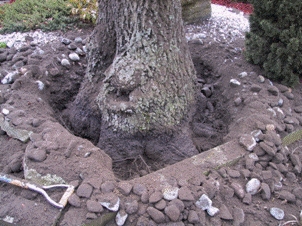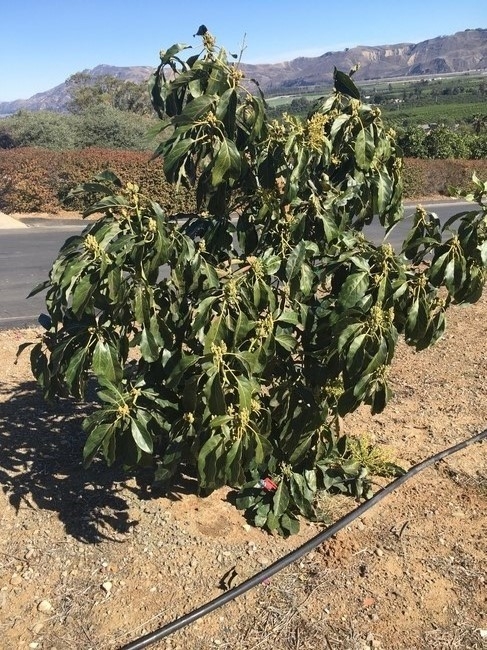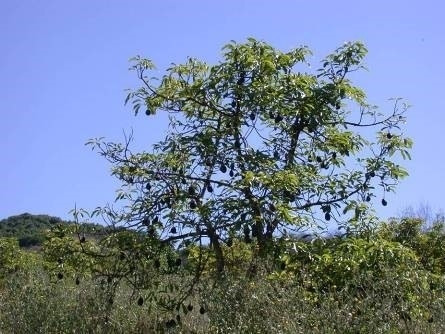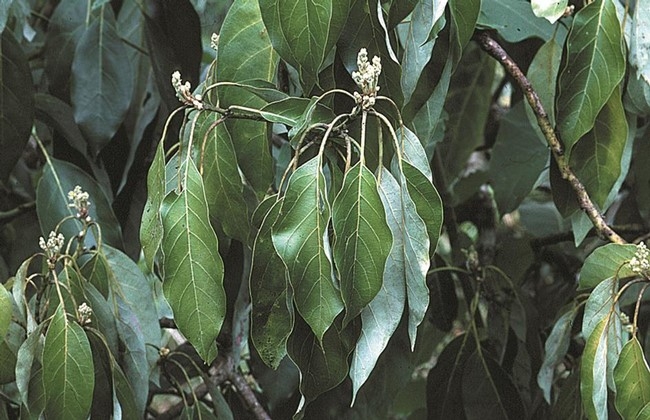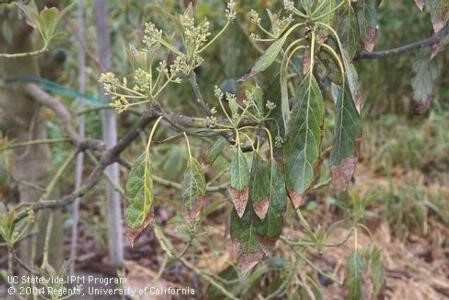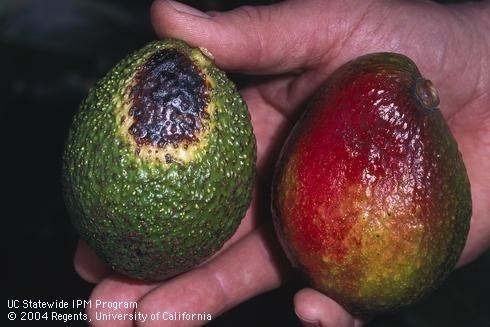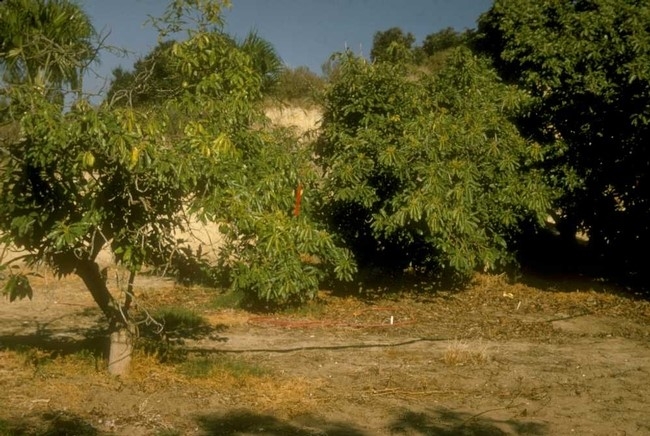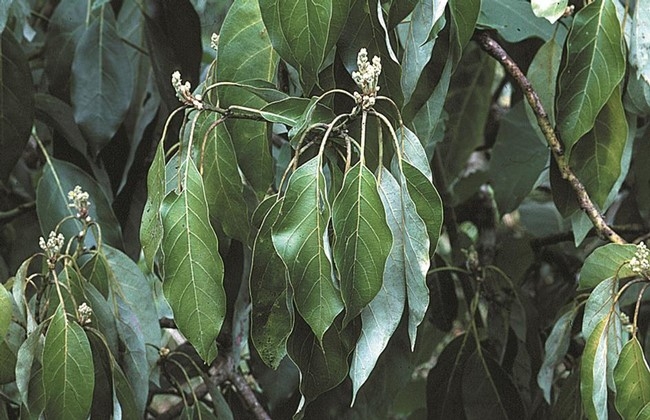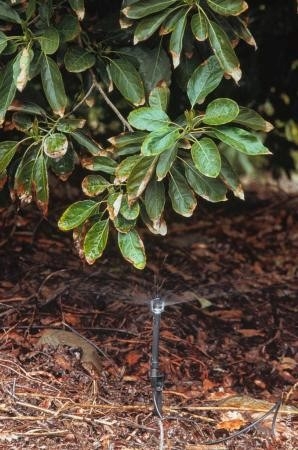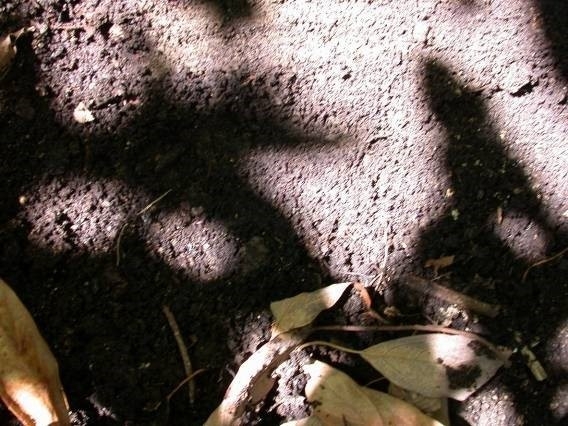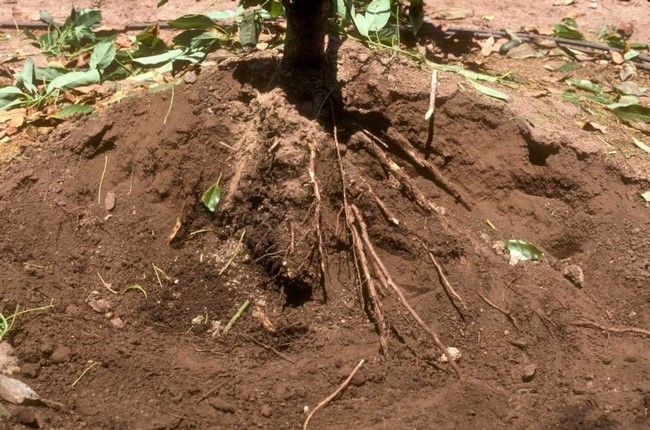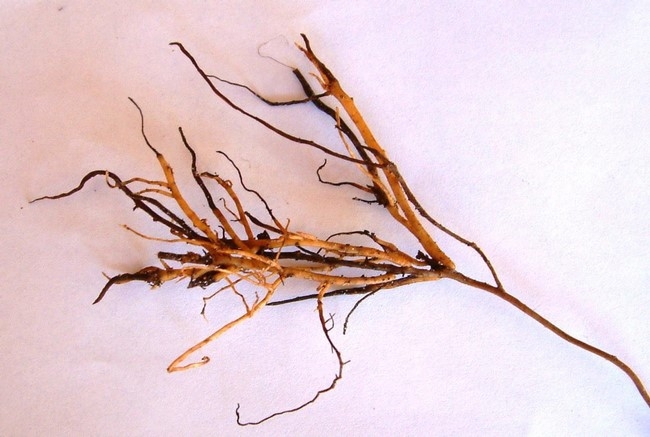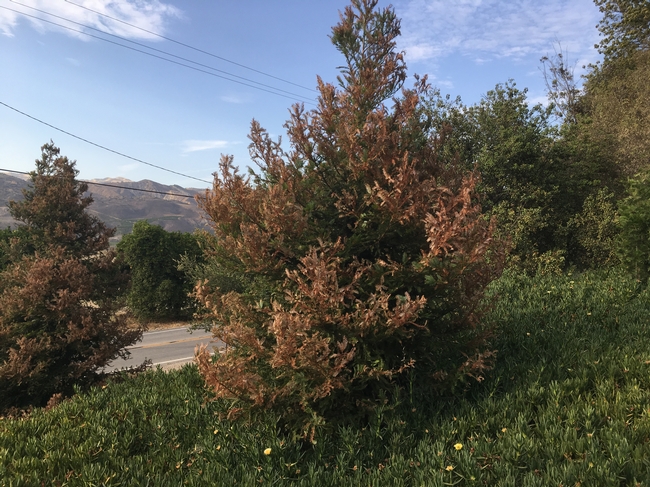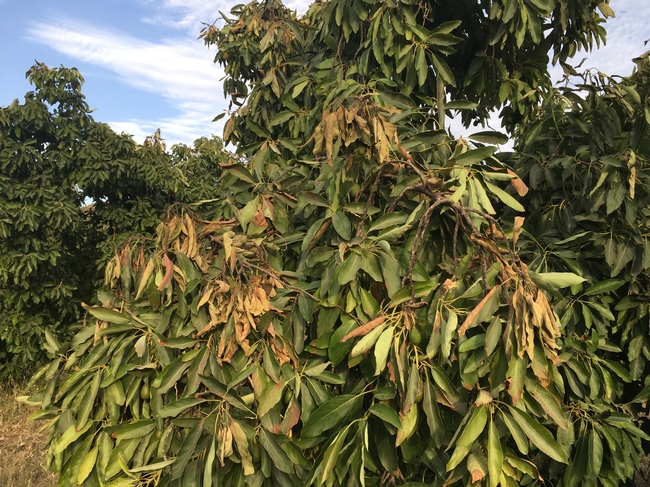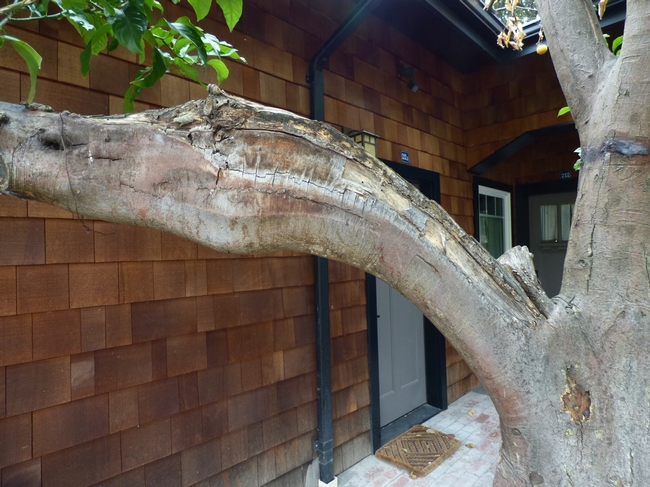- Author: Ben Faber
We recently had a series of workshops on Avocado Root Rot and ways to manage it. A common question was how to figure out whether the tree was diseased with Phytophthora cinnamomi or just stressed from lack of water. Drought is also compounded and confused by salt accumulation, which is a reflection of how water is being managed. It might be the right amount, but not timed correctly. Too much at one time means the water goes beyond the shallow root system, too little at an irrigation and the salts contained in the water start being taken up by the roots. These “extra” salts need to be leached; otherwise, they actually compete with the tree for soil water. By “extra”, these are the salts like sodium and chloride that can be harmful to the tree, rather than the nutrient salts that are necessary for tree growth, but will also be leached when trying to achieve a balance by removing the harmful salts.
So there are several steps to follow to figure out a droughted tree from a root rotted tree. If the tree is stressed from drought, eventually though, it quite likely can lead to root rot. Looking at wilted leaves is an indication of a stressed root system which is common with a lack of water, but can happen when the roots are soaked for too long from rain, a leaky irrigation system or sediment accumulation that can occur with flooding. Wilting is also one of the first symptoms of root rot, because there are not sufficient roots to keep up with the tree's water demand.
Step I. Wilting
Wilting is going to be the first step in alerting you to a soil/root/water problem, but it is just the first alert and there are more steps to a field diagnosis. The steps take on three different parts of the tree:
First, look at the canopy overall and then more closely in the canopy
Then, look AT the ground
Then, look IN the ground
If you look at the tree from a distance and the canopy is thinning with dieback (staghorning)
Step 2: Thinning canopy.
This means that it is something that has been going on for a longer time that just to cause the leaves to flag (wilt)
And when you look more closely, the leaves are small, yellow, have tip burn and there are lots of flowers
Steps 3, 4, 5: Small, yellow leaves; tip burn; profuse flowering
This again means that it's something that just didn't happen with a missed irrigation or two, or a stopped up emitter. Something has been going on for maybe more than a season.
And if there is fruit, if it is sunburned which means it probably isn't saleable, it means there isn't enough canopy to protect income
Step 6: Small, sunburned fruit
Now you definitely know there is a problem with the roots. The roots mirror the canopy. When they go wrong, they canopy goes wrong. All these thinning symptoms in the canopy, also means the root system is thinning. Also, when the canopy goes wrong, the roots have problems. When the canopy can't feed the root system it is less able to fend off disease, if that is the cause of the thinning canopy problem. At this point, it's not definitive that it is root rot causing the problem, but a sad canopy can lead eventually to a root rot problem because of lack of energy generated in the canopy.
The next step is to look AT the ground surface and see if there's natural leaf mulch. If the tree lacks energy to produce leaves, there won't be any leaf drop and now leaf accumulation. These should be leaves in various stages of brown, indicating they have been there for a while. This mulch protects the roots from drying out and also produces an environment hostile to the root rot organism. No leaves to feed the fungi and bacteria that compete and destroy Phytophthora, eventually Phytophthora will come to dominate the system. No energy to produce leaves; no canopy to protect leaf mulch from wind? And, then the wind blows the leaves away. On hillsides, gravity can act against mulch creation and also exposes trees to more wind, but a healthy tree can create its own mulch in harsh hillside environments.
Step 7: No natural leaf mulch
With a sick canopy and no natural leaf mulch, this is the time to think there is something seriously wrong. There is something wrong with the water uptake in this tree. Either a lack of water or a lack of roots. Is it the timing, amount or distribution of the water? These are all issues that can be corrected if there is sufficient water to do so. Maybe the soil is too wet? It could be asphyxiation. Lack of air. That can be corrected by identifying the cause of the lack of air or too much water.
Step 8: Asphyxiation
But if the soil is not too wet, when you apply water, does the tree perk up? Give it a couple of days. This could always have been the problem. Does the water come on? Is a valve shut down? Is the system not working? Is there poor water distribution. This infrastructure problem is common in hillsides irrigation with cheap parts that are easily damaged by coyotes, rabbits, and pickers.
Step 9: Turn on the water
But if the tree does not or has not responded to applied water, then start digging. It's time to look IN the ground. This is something that should be done on a regular basis just to see how those roots are doing, anyway.
And when you start digging, there's no roots
Step 10: NO roots
Or only big roots
Step 11: Only big roots
And, if you do find any little roots, they are blackened and brittle
Step 12: dead root tips
And you have applied water and the tree doesn't perk up, then the tree probably has Avocado Root Rot disease caused by Phytophthora cinnamomi.
There can be other reasons, for a tree collapse like this, like a gas pipe leak, gopher activity in young trees, a chemical/fertilizer spill. Probably other things that kill roots, but a field diagnosis like this process can pretty much identify the problem as root rot. It can then be verified by a lab test to make sure. However, there are times of the year and disease conditions when a test will come back negative and it might be necessary to retest with another sample at another time of year.
Most groves that have been in the ground for many years and have been harvested by outside commercial crews quite likely have the root rot organism present in the orchard. The lack of disease is because the stress that brings on disease is lacking – water management, frost/heat damage, flooding, too much rain, too much fruit, pruning, etc. – anything that predisposes the tree to infection. It is when several stresses are present that the trees start declining and if identified soon enough can be corrected and the decline stopped and reversed.
- Author: Ben Faber
So, this weekend we had some hot weather and the damage from that heat is apparent in all kinds of plants. Sycamores, cottonwoods and willow in the Santa Clara River bottom look torched. Redwoods in the landscape look like a new disease has hit them.
Even old coast live oak in Ojai have been toasted. Orchards have been hit also with been hit without exception. This has been a widespread weather phenomenon like a major freeze. And the trees should be treated as if they have been freeze damaged.
http://ucanr.edu/blogs/blogcore/postdetail.cfm?postnum=12275
So, what to do with the avocados and citrus that have been hit? Well, if it's just a slight toasting, nothing. They will grow out of it. It's a setback. The growing points, the terminal buds, have been damaged and in the case of avocados those may not flower next spring. If the damage is not extensive, the whole canopy has not been damaged, then flowering should be sufficient for a good crop next year. If the whole canopy has been hit, it's likely that flowering will be minimal next year.
If the trees have lost significant portions of the canopy, though, the heat damage is not the problem, it's the sunburn damage that is going to happen that is the problem. It's the loss of the leaves that transpire and cool the tree that lead to this kind of damage that can kill small trees and lead to significant branch loss in older trees.
The leaves act like the radiator in a car. They move water through the tree and that water movement carries off the heat that accumulates in the branches and stems. When water flow stops, the bark heats up and tissue is damaged. The worst-case scenario occurs when a “renovated” tree that has been brought down to 6 feet in January and since then there has been new growth all over the tree. The heat fries that new growth and now the whole tree structure is exposed to sunburn damage.
The branches exposed to the sun need to be protected with whitewash. The whitewash needs to be WHITE, not grey. It needs to be able to reflect the sun and prevent the surface from heating. The tops of branches and the west and south sides need to be the most protected, so it often involved hand work. And it needs to be done soon after the canopy loss. That wood heats up fast and damage occurs soon after it heats up.
So what else needs to be done? No canopy, no water loss, so it's necessary to manage the water differently. With no leaves, there is no water moving from soil through the tree, so it just sits there, and the ground stays wet. Perfect conditions for root rot.
Growers who were watering their trees knowing that a heat spell was coming, did the right thing. It probably reduced the severity of the damage, but even growers who had water on before the heat and it was running during the heat have had damage. With canopy damage and loss, applied water needs to be restricted to just enough to get tree recovery without creating a wet, soggy condition. And with tree recovery, it's going to need a continually changing irrigation schedule as new growth occurs.
So now more than ever, water to the tree's growing needs. And the normal fertilizer program needs to be adjusted. There's probably sufficient nutrients in the soil from prior fertilization that nothing new needs to be applied.
And don't' prune the trees. Leave the hanging leaves there. They will help protect the tree from sunburn, but the extent of the damage is not clear. Let the tree push new growth and that will tell you sometime in the future 3-6 months, even a year from this event, when to do significant pruning.
Phlood, Phyre, Phrost, Fytophthora and Phahrenheit continue to plague our industry. It seems like we are always coping with some natural and some unnatural issues affecting agriculture. Oh, yeah and pH.
Photo: Heat singed new avocado growth.
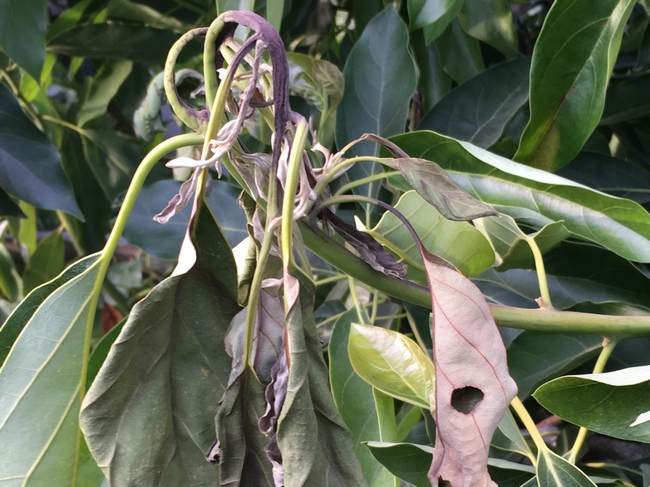
- Author: Ben Faber
PULLMAN, Wash. Soil pathogen testing - critical to farming, but painstakingly slow and expensive - will soon be done accurately, quickly, inexpensively and onsite, thanks to research that Washington State University scientists plant pathologists are sharing.
As the name implies, these tests detect disease-causing pathogens in the soil that can severely devastate crops.
Until now, the tests have required large, expensive equipment or lab tests that take weeks.
The soil pathogen analysis process is based on polymerase chain reaction (PCR) tests that are very specific and sensitive and only possible in a laboratory.
The new methods, designed by WSU plant pathologists, are not only portable and fast, but utilize testing materials easily available to the public. A paper by the researchers lists all the equipment and materials required to construct the device, plus instructions on how to put it all together and conduct soil tests.
Responding to growers needs
"We've heard from many growers that the time it takes to obtain results from soil samples sent to a lab is too long," said Kiwamu Tanaka, assistant professor in WSU's Department of Plant Pathology. "The results come back too late to be helpful. But if they can get results on site, they could make informed decisions about treatments or management changes before they even plant their crop."
Some diseases from soil pathogens may not be visible until weeks after the crop has sprouted, Tanaka said. That could be too late to treat the disease or could force farmers to use more treatments.
Magnetic breakthrough
WSU graduate student Joseph DeShields, a first author on the paper, said it took about six months of work to get their device to work in the field. It relies on magnets to capture pathogens' DNA from the soil.
"It turns out, it's really hard to separate and purify genetic material from soil because soil contains so much material for PCR tests," said DeShields "So we were thrilled when we made that breakthrough."
Rachel Bomberger is a WSU plant diagnostician who helped with the concepts of the machine testing. She said she's impressed by what Tanaka and the team accomplished.
"We removed a huge stumbling block when it comes to soil testing," said Bomberger, one of the co-authors on the paper. "We found the missing piece that makes the testing systems work in the field without expensive lab equipment or testing materials."
Worldwide application
The system was tested on potato fields around eastern Washington, Tanaka said, but it will work on soil anywhere in the world.
"It's a really versatile method," he said. "You could use it for nationwide pathogen mapping or look at the distribution of pathogens around the country. We started small, but this could have huge implications for testing soil health and disease."
Tanaka said it was important for this discovery to be available in an open-access video journal.
"We're always concerned about helping every grower and the industry as a whole," Tanaka said. "We want everybody to look at this and use it, if they think they'll benefit from it."
###
The results were published in the Journal of Visualized Experiments, an open-access journal that includes a video showing how to assemble and used the system and a full list of materials needed to use their method.
This research is supported by the Northwest Potato Research Consortium and the Washington State Department of Agriculture - Specialty Crop Block Grant Program.
See the video here:
And the article here:
https://www.jove.com/pdf/56891/jove-protocol-56891-on-site-molecular-detection-soil-borne-phytopathogens-using-portable
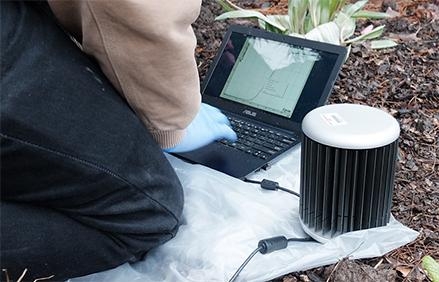
- Author: Ben Faber
No rain for several years may have let citrus growers think that brown rot control is not important. But it still is and it's just coming out after a few inches of rain earlier this January. This is not the brown rot of stone fruits caused by Monilina fungus but a pathogen, completely different – Phytophthora spp.
Symptoms appear primarily on mature or nearly mature fruit. Initially, the firm, leathery lesions sometimes have a water-soaked appearance. Lesions are tan to olive brown, have a pungent odor, and may turn soft from secondary infections. Infected fruit eventually drop. Occasionally, twigs, leaves, and blossoms are infected, turning brown and dying.
Brown rot is caused by multiple species of Phytophthora when conditions are cool and wet. Brown rot develops mainly on fruit growing near the ground when Phytophthora spores from the soil are splashed onto the tree skirts during rainstorms; infections develop under continued wet conditions. Fruit in the early stage of the disease may go unnoticed at harvest and infect other fruit during storage.
Brown rot management primarily relies on prevention. Pruning tree skirts 24 or more inches above the ground can significantly reduce brown rot.
One spray of copper fungicide between October and December before or just after the first rain may provide protection throughout the wet season. When rainfall is excessive, you may have to repeat the spray in January or February. Spray the skirts to about 4 feet above ground. Spraying the ground underneath the trees also reduces brown rot infections. In addition to copper, other products effective against brown rot include the phosphonate and phenylamide fungicides. Phosphonates are applied as foliar and fruit or soil treatments, whereas phenylamides are applied as soil treatments for brown rot control. For soil applications, microsprinkler irrigation applications may be used.
Recently, oxathiapiprolin (Orondis®) was registered for use on citrus in California. Orondis® is an outstanding alternative for Phytophthora control that may be applied as chemigation or foliar application. However, foliar applications are preferred for preventing brown rot.
Postharvest Packinghouse Treatments to Prevent Fruit Decay
Potassium phosphite fungicides may be applied in aqueous dilutions to fruit alone or in combination with other postharvest fungicide treatments to manage nonvisible infections that occurred before harvest or protect fruit from brown rot infection after harvest during storage, distribution, and marketing. Use high-volume flooder or dip treatments for maximum coverage of fruit. Heated (125–136°F) fungicide solutions optimize performance of the potassium phosphite treatment.
More citrus brown rot information is at:
http://ipm.ucanr.edu/PMG/r107100711.html
Packers should check the Global MRL Database for all country MRLs at https://globalmrl.com/db#pesticides/query.
Photos of brown rot on different citrus varieties - lemon, mandarin, orange
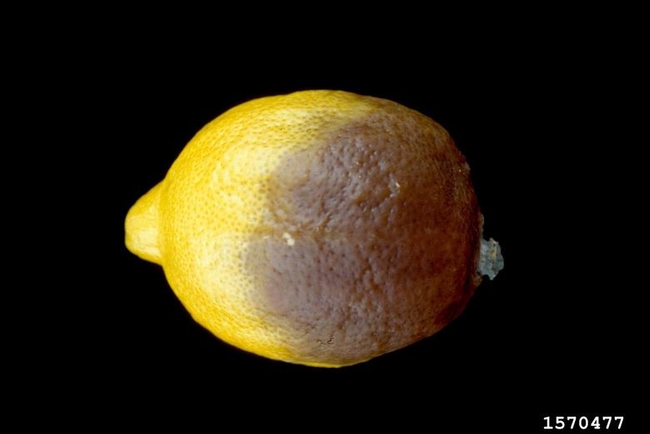
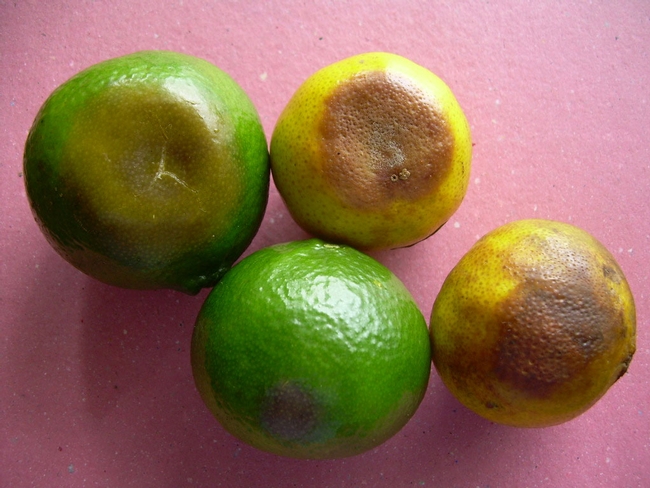
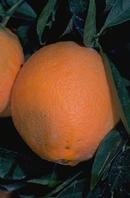
- Author: Ben Faber
A trunk "below grade", that is a buried trunk, is a problem for most trees. Willows and other riparian trees along water ways that are inundated regularly can adapt to a change in soil depth around their trunks. That's not true of most of our commercial tree species, and avocados and citrus are really susceptible to buried trunks/stems. they asphyxiate. This can be a very common problem at planting when a hole is too deep and the new tree settles in the loosen earth and gradually the stem is buried. Or, when the grower is doing the "right thing" and using an organic planting mix that gradually decomposes and the tree settles into the ground and the crown is covered by dirt. The tree then starts looking bad - leaves yellow. The canopy defoliates. All the while, the grower is putting on more water and more fertilizer and the tree looks worse and worse. Remove the soil from around the base, and voila, in a few months the tree is happy again. If the dirt isn't moved, the stressed tree is now susceptible to root rots, both Phytophthora and Armillaria. Those problems are a lot worse than just lack of air.
This suffocation is a common problem after flooding. Dirt from higher up moves into lower positions, gravity moving dirt can move a lot. It accumulates around the base of the tree. The grower is preoccupied with other things that occur with flooding and does nothing. A few months later, the trees start turning yellow especially when the weather warms up and they are more active and more water is being applied. Flooding can also spread disease organism from other areas that are contaminated. Oak root fungus is frequently spread in flooding waters, especially in the lower positions in little valleys.
Pulling that accumulated soil away from tree is important for tree health. It's something that needs to be done soon after the flooding incident, or any event that buries the tree trunk.
